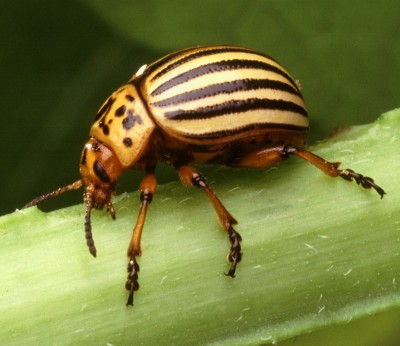Colorado potato beetle
 Scientific Name
Scientific Name
Leptinotarsa decemlineata
Hosts
Colorado potato beetles infest a wide variety of cultivated and wild solanaceous plants, including potato, eggplant, tomato, pepper, tobacco, ground cherry, buffalo burr, and horse nettle.
Symptoms
 Both adults and larvae feed on the leaves and terminal growth of their host plants.
The loss of foliage hinders development of tubers or fruit, thereby reducing yield.
In cases of heavy infestation, entire plants may be killed. Overwintered adults can
be heavy enough to cause extensive damage to young plants, and larvae are capable
of causing severe defoliation on older plants. Potato beetles generally feed from
the outside of the leaf in towards the mid-vein.
Both adults and larvae feed on the leaves and terminal growth of their host plants.
The loss of foliage hinders development of tubers or fruit, thereby reducing yield.
In cases of heavy infestation, entire plants may be killed. Overwintered adults can
be heavy enough to cause extensive damage to young plants, and larvae are capable
of causing severe defoliation on older plants. Potato beetles generally feed from
the outside of the leaf in towards the mid-vein.
Life Cycle
Adults overwinter in the soil. They emerge in April, about the time potatoes crack the ground, and feed for a short period before mating and laying eggs. Females each deposit 300 to 500 eggs in clusters of 20 or more on the undersides of leaves over a period of 4 to 5 weeks. Larvae hatch in 4 to 9 days and feed for 3 weeks, often in groups. Mature larvae drop to the ground and pupate in the soil. A new generation of beetles emerges 5 to 10 days later. There can be 2 or 3 generations per year.
Description
The adults are about 3/8 inch long by 1/4 inch wide, oval, and very convex. They are yellowish brown with five black stripes on each wing cover and small black spots on the pronotum. The eggs are elongated and yellow or orange. They are laid on end and grouped into rows. Newly hatched larvae are cherry red with black heads and legs. They are humpbacked and soft bodied. As they grow, they turn yellowish red or orange and develop two rows of black spots along each side of the body. They reach a length of about 3/8 inch when mature.
Control
Please contact your local county extension office for current information.
